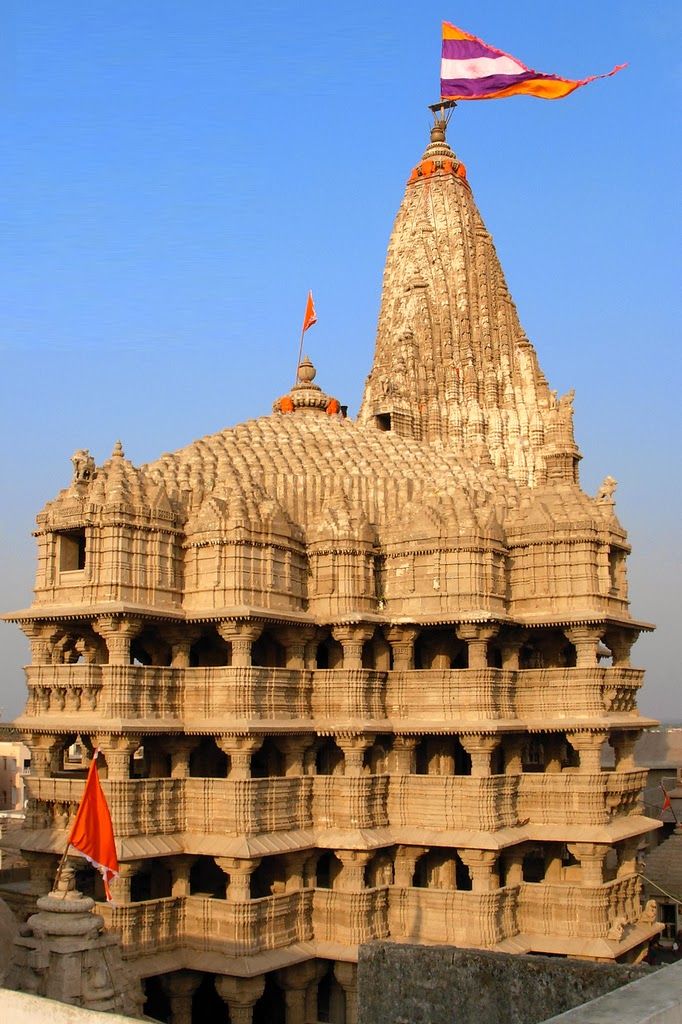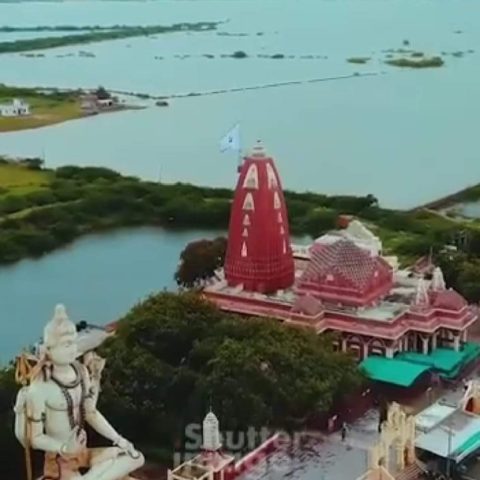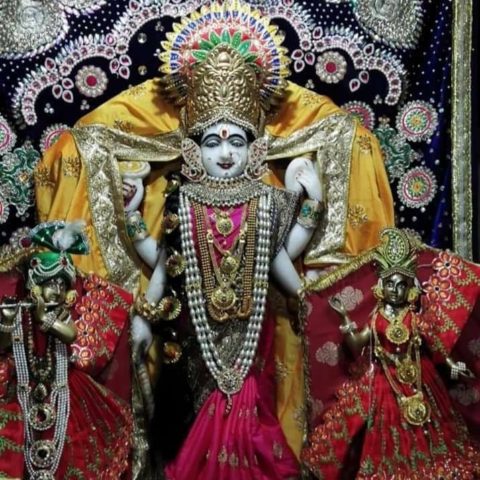
Dwarkadhish Temple is the main attraction of Dwarka city located in the Devbhumi Dwarka district of Gujarat (India). Also called the ‘Jagat Mandir’, it houses the Deity of Lord Dwarkadhish. Lakhs of devotees flock to this famed temple every year to catch a glimpse of the charming lotus face of Sri Dwarkadhish. It is the 98th Divyadesham as per the Divya Prabhandam text of the Sri Vaishnavas.
The temple seems to rise from the Arabian Sea when looked at from a distance. It’s majestic construction in limestone with heavy sculpting on the walls makes it one of the grandest temples in India. A lot of devotion has been infused in the construction and renovation of the temple which has witnessed many attacks from barbaric kings. Raja Jagat Singh Rathore is said to have rebuilt the temple. Hence, the name ‘Jagat Mandir’.
The flag of Dwarkadhish Temple
A massive flag measuring 52 yards flaps atop the shikhara of Jagat Mandir. It is made in different colours except black depicting the sun and moon. The 52 yards of the flag represent clans of devotees who flourished under the rule of Lord Krishna in Dwarka. The flag changing ceremony is very special here. It happens five times in a day; three in the day and two in the evening. The flags are sponsored by various individuals or families. It is a great honor for a family who sponsors the flag of Sri Dwarkadhish.
Dwarkadhish Temple: The history
The Dwarkadhish temple was originally constructed by Sri Vajranabha, Lord Krishna’s grandson. It is constructed exactly at the spot where Lord Krishna’s residence used to be. The original temple had an umbrella like structure with the Deity of Lord Dwarkadhish beneath it as per the temple authorities. As per the ASI (Archaeological Survey of India), the current basic temple structure is around 1200 years old which was developed around the ancient and original structure. Read about the opulence of Dwarka.
Many renovations have been done by various Kings and eminent personalities. The temple was destroyed by Mahmud Begada of the Gujarat Sultanate in 1472, and then renovated, enlarged in the 16th century using the Chalukya style of architecture.
Adi Shankaracharya had visited the temple in 800 CE and got it renovated. A memorial inside the temple complex celebrates his visit and renovation. His representative samadhi is also present in the Paduka form. The temple also houses the eastern Sharada Peetha out of the four Peethas established by Adi Shankaracharya in the four directions in India to preserve and propagate Sanatana Dharma.
The Temples within Dwarkadhish Temple Complex
The charming Deity of Lord Dwarkadhish at the Dwarkadhish temple is a feast for the eye. Standing in a four-armed form, the Deity represents the Trivikrama form which is one of the twenty-four forms of Lord Narayana. This Deity is the pratibhu murti of the original Dwarkadhish and was found in a well called Savitri Vaav. The original Deity is being worshiped in Dakor.
Lord Dwarkadhish is adorned gorgeously every day. He receives an elaborate shringar multiple times of the day. On special occasions such as Janmashtami, the shringar is even more mesmerizing.
The Architecture of Dwarkadhish Temple
The Dwarkadhish temple consists of the Garba-Griha, Sabha Mandap, Antarala, and entrance porch. It is 250 feet high with a 25 feet high flagstaff on the top. The main Shikhara is around 170 feet high. The temple in general has a Solanki style architecture prevalent in Gujarat for a long time. But it was rebuilt in Chalukya style architecture in the 16th century.
The main temple is dated back to 12th/13th century while the Sabha Mandap is dated back to 15th/16th century. The Mandap has a tiered Shikhara and stands on 72 pillars all made from a single stone. There are five floors overall.
There are two entrances to the temple complex called as Swarg Dwar (Southern entrance) and Moksh Dwar (Northern entrance). There are 56 steps from the Gomti ghat towards the Swarg Dwar.
Temples within the Jagat Mandir
A smaller temple dedicated to Lord Balarama is present within the temple complex, to the left of Lord Dwarkadhish’s temple. While the Deities of Aniruddha and Pradyumna are present in another temple to the right of Lord Dwarkadhish’s temple. There are temples dedicated to Sage Durvasa, Ambaji, Radha-Krishna, Beni Madhav, Gayatri Devi, Kusheshwar Mahadev and Purushottam Rai.
The temple of Devaki Devi, Lord Dwarkadhish’s mother is exactly opposite the altar of Lord Dwarkadhish. She is placed in a way that she can always behold the beauty of her son and overlook all the sevas which are offered throughout the day.
There is a separate structure with a courtyard in the middle called ‘Pattarani Mahal’ where there are Deities of Lakshmi-Narayana, Radhika, Saraswati, Bala-Gopal, Satyabhama, and Jambavati. The original Sri Chakra installed by Adi Shankracharya is worshiped within this temple. The inaccessible temple of Chalati Mata is present on the fourth floor of Dwarkadhish Temple.
Dwarkadhish Temple timings and the vibrant festivals
The temple has a very organized and vibrant way of conducting its day-to-day activities be it darshan or festivals. It is open for the devotees from 6.30 AM to 1.00 PM. It reopens again at 5.00 PM in the evening and closes at 9.30 PM.
Janmashtami is the biggest festival celebrated at the Dwarkadhish Temple. Lakhs of pilgrims visit on this day. The festival is streamed live on the national channel Doordarshan for those unable to make it.
Holi is celebrated here in the mood of the Holi celebrated in Vrindavan dham. Also important is the Rukmini Vivah ceremony i.e., wedding ceremony of Sri Krishna and Rukmini Devi on the Ekadashi day of the Chaitra masa (around March).
Other festivals celebrated include Basant Panchami, Diwali, Dhanteras, Ram Navami, and Akshaya Tritiya.
How to reach Dwarkadhish Temple
Being in Dwarka city, you must travel there to relish the darshan of Sri Dwarkadhish. If you wish to make most out of your visit to Dwarka, join the Pancha Dwarka Yatra of Tirtha Yatra in which guided tour to Dwarkadhish Temple is included.
You can use the following means of travel:
By Land: Dwarka is well-connected to major towns and cities. You can travel using a private vehicle. Or else, enough taxis and buses are available from Jamnagar, Porbandar and nearby cities.
By Rail: Dwarka has its own railway station (DWK) which is well connected to major cities in India. You can catch a train that goes directly to Dwarka or makes a stopover. So, no worries about changing buses or cars.
By Air: The nearest airports to Dwarka are in Jamnagar and Porbandar. You can fly into Jamnagar/Porbandar and catch a taxi or bus to Dwarka.
1












Comment On Dwarkadhish Temple
Ramdas
Thank you. Very good information